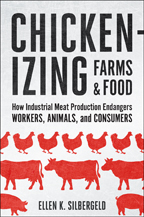Chickenizing Farms and Food: How Industrial Meat Production Endangers Workers, Animals, and Consumers
- By Ellen K. Silbergeld
- Johns Hopkins University Press
- 336 pp.
- Reviewed by John R. Wennersten
- February 9, 2017
A well-researched, sobering look at “big agriculture” in America.

In Chickenizing Farms & Food, Ellen K. Silbergeld, a professor at the Johns Hopkins School of Public Health, focuses on the industrialization of food-animal production in the United States, with special emphasis on the poultry industry. She paints a grim picture.
Silbergeld warns that the massive use of antibiotics in chicken feed to promote rapid growth is now producing drug resistance to these antibiotics in humans who consume the meat. “For what then,” she asks, “are we risking the crown jewel of modern medicine to prevent and cure deadly infections with antimicrobial drugs?”
Silbergeld argues that there is no scientific rationale to support the use of growth-promoting antibiotics in animal feed. “The Food and Drug Administration has never issued a requirement [to the poultry industry] to submit additional data on either the claimed efficacy or hazards of antimicrobial feed additives.”
Besides, chickens can fatten up simply by being kept in clean houses; antibiotics may prove to be unnecessary. “It continues to amaze me,” she writes, “how limited and inadequate the information we have relied on has allowed an enormous misuse of antimicrobial drugs, and the extent to which all parties have continued to resist any change.”
Americans as consumers of food are concerned with convenience, price, and availability. We don’t much care, the author notes, about what goes into the chicken we eat. We don’t fret about the pathogens and other contaminants that poultry houses release into the environment, nor do we worry about the drugs poultry producers give to their birds.
Perhaps we should.
In a lengthy analysis, Silbergeld argues that it’s important to get beyond the “hollow claims” of the food-animal industry not substantiated by research. Poultry litter contains many types of microbes transmittable to humans. It is also a reservoir for bacteria that cause diarrhea and dehydration. And scientists today have found a new strain of salmonella resistant to the powerful antibiotic Cipro. The primary carrier of the strain? Poultry.
In the United States, there is a public mentality that holds fast to the Arcadian image of the family farm. But agriculture is now a big industry that employs the same methods of integration, production, and distribution as do other mass-production businesses. Industrial agriculture has changed the social order, landscape, and economic structure of rural America. Farming has become commodified.
Mason Dixon Farms near Gettysburg, Pennsylvania, is one example of the new industrial agriculture. There, hundreds of dairy cattle are kept in stalls for their entire lives. A machine periodically comes by to tilt each cow on its side and trim its hooves. Manure is swept through water mains to a power plant for methane-produced electricity.
Similarly, at the Maryland farms contracted by behemoth Perdue to raise its chickens, the emphasis is on housing the maximum number of birds in the minimum space, despite the potential for animal suffering and food-supply contamination. Another unfortunate reality: Nearly all the risks are assumed by the local grower/farmer, who rarely earns more than a nickel a pound for the poultry. The “integrators” like Perdue, who own the birds, the feed, the antibiotics, the slaughterhouses, and the distribution system, reap the major profits.
Silbergeld believes the world of food-animal production has changed little since Upton Sinclair wrote his classic exposé of the meatpacking industry, The Jungle, in 1904. Given the current conditions in large-scale chicken houses and poultry slaughterhouses, food safety is far from certain. Several states, she notes, have passed legislation — called “ag-gag” laws — that criminalizes the revealing of hazardous or inhumane conditions inside these facilities.
Looking at food-animal production today, Silbergeld believes it’s not an either/or proposition where we choose between industrial agriculture and community-supported farms. The smaller operations simply do not have the capacity to feed the United States and provide a surplus for hungry nations; industrial food production is here to stay. However, it needs to be more closely regulated and held to standards set by entities like the Environmental Protection Agency and the Clean Water Act.
Silbergeld writes in an easy, conversational style that demonstrates a sweeping knowledge of human history ranging from the Egyptians to Immanuel Wallerstein’s works on the modern world system. She also marshals an impressive array of facts to defend her case. Chickenizing Farms & Food is a must-read for anyone who cares about the production of the things we eat.
John R. Wennersten is an environmental policy writer and emeritus professor of American history at the University of Maryland, Eastern Shore. His new book, Rising Tides: Climate Refugees in the Twenty-First Century, co-authored with Denise Robbins, will be published this spring by Indiana University Press.

